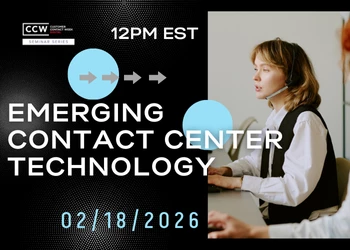Don't Ignore The "RM" In "CRM"
CRM stands for customer relationship management -- not customer interaction recording.
Add bookmarkAiming to help businesses transform from entities that "supply products" into organizations that "connect with customers," CCW Digital recently launched its complimentary Special Report on CRM.
The research-driven analyst briefing explores some key topics:
- Challenges and misconceptions preventing businesses from cultivating relationships with customers.
- Top 5 priorities for those making CRM investments.
- 5 signs of a customer-centric CRM initiative.
- 4 questions to ask when building your CRM strategy.
- 11-step roadmap to great customer relationships.
You can download your complimentary copy here.
An excerpt of the report -- "Don't Ignore The 'RM'" -- is embedded below.
When it comes to the customer contact space, few terms are more familiar than “CRM.” Customer contact professionals universally recognize the abbreviation. They know it stands for customer relationship management. More importantly, they understand the importance of cultivating great customer relationships.
Unfortunately, many customer contact leaders forget this knowledge when actually sourcing, implementing and administering CRM solutions.
These leaders mistake customer relationship management for “customer interaction recording.”
They may license powerful “CRM” solutions for their contact centers, but they do not leverage these tools to cultivate strong customer relationships.
They instead focus exclusively on the reporting component. Urging agents to properly submit interaction data into the system becomes their primary, if not only, objective.
In addition to fundamentally missing the point of CRM, this approach creates clear inefficiencies and clear sources of agent dissatisfaction. More importantly, it hinders the organization’s ability to do the very thing it set out to accomplish: improve customer relationships.
“Time is money” in the contact center, but its value is squandered when agents are assigned low-value tasks. “Customer interaction recording” is one of those tasks.
No, there is nothing fundamentally wrong with asking agents to chronicle their interactions in the CRM system. The health of the customer experience, in fact, depends on active input from front-line employees.
The error comes when the business makes “data entry” the priority for CRM strategy. In doing so, the organization is asking agents to spend time away from customer interactions (their quintessential “high-value task”) – without any guarantee of a return on that investment.
The data agents input has no inherent value; it is information they already know about interactions that have already happened. This “tracking data” may help leaders manage agent workflow in its native state, but it neither improves the customer experience nor aids agents in better contributing to that experience.
Without that promise of value, the organization is wasting its agents’ time – and thus succumbing to a potentially costly inefficiency. It may also be hurting agent satisfaction; few agents enjoy pointless data entry, and they may downright resent the task if it is used to micro-monitor – rather than empower – their workflow.
The organization, more importantly, is hindering its ability to build meaningful customer relationships. Data holds the keys to anticipating needs, personalizing experiences and reducing pain points, all of which contribute to better relationships. None of these benefits can be realized, however, if the intelligence remains in a dormant state.
“Does the system exist to collect data that most agents and sales reps already know, or does the system exist to provide value to the agent and sales rep and enable them to serve the customer,” asks John Seeds of Avtex. “Unfortunately we see most organizations implementing CRM systems to capture more customer data and activity data (in a “big brother” context) than we do providing value to the agent.”
True “CRM” is not about chronicling this data itself. It is about the process of transforming the data into actionable intelligence that empowers agents to empower customers.
This process involves pairing agent insights with customer feedback, analytics and other “whisper” data from all touch points. Once this real-time, universal data flow is established, the CRM solution must then parse the data into intuitive, useful narratives for live agents and self-service engagement platforms.
It should provide vivid insights into the profiles, histories, sentiments and preferences of individual customers. It should also provide aggregate insights that help the organization anticipate how other customers may behave over time.
When the data reaches this stage, agents have what they need to deliver better experiences and build stronger relationships. Agents will be happier and more productive. Both work to the benefit of customers – and the business.





















